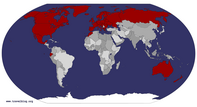Spain/Portugal/Italy 2009
September 25th 2009 -» October 12th 2009
Croatia/Germany 2010
June 25th 2010 -» July 10th 2010
Flyover America July 12-16, 2014
July 12th 2014 -» July 16th 2014
Canadian Rockies and Glacier National Park August 2014
August 2nd 2014 -» August 17th 2014
Charleston the long way September 2014
September 14th 2014 -» September 24th 2014
World War II Tour - June 2016
June 2nd 2016 -» June 24th 2016
Southern England 2022
May 3rd 2022 -» May 17th 2022









